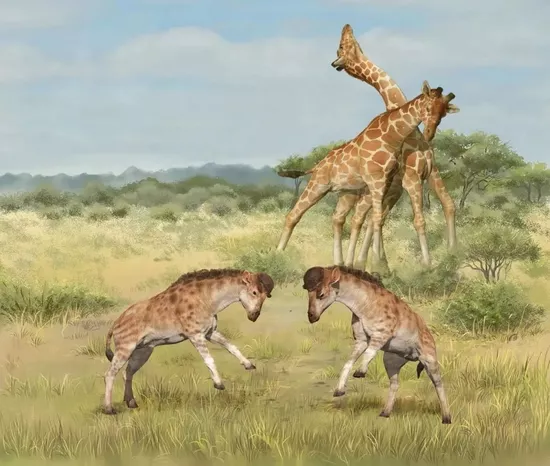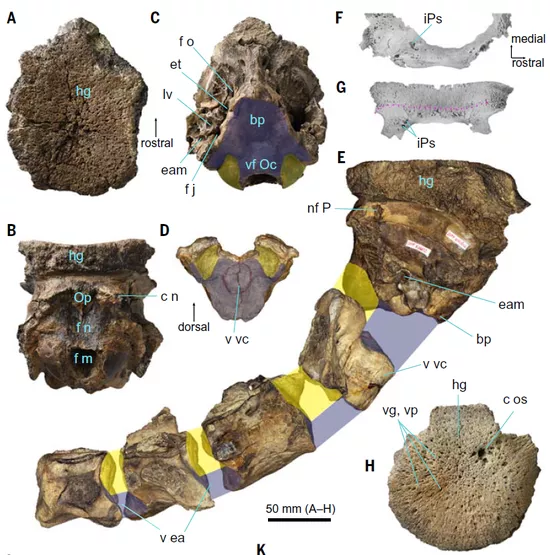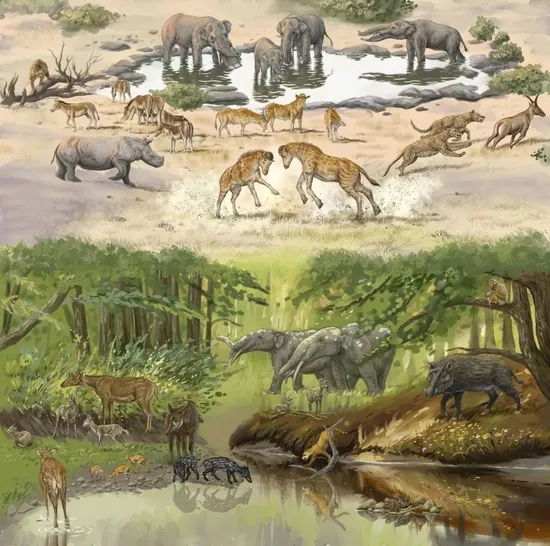The neck more than 2 meters long constitutes the most prominent feature of giraffes, making them the tallest animals on the earth today. So, how did this unique neck in the world come from? Today, in a study published in the journal Science, the research team of the Institute of Vertebrate Paleontology and Paleoanthropology (IVPP) of the Chinese Academy of Sciences found new evidence for the evolution of giraffe neck from a strange ancestor of giraffe. It is pointed out that male courtship competition is an important driving force for giraffe neck evolution**

The most famous controversy on this issue comes from Lamarck and Darwin. As we know, Lamarck has put forward the hypothesis of "use in and waste out" and "acquired inheritance": according to the former, giraffes need to use their necks constantly to eat leaves at the top of trees, so their necks become longer; According to the latter, these new traits may be passed on to offspring, making long neck a common trait.
Darwin refuted that the giraffe's long neck is the result of natural selection according to the viewpoint of adaptive evolution: in the woodland of the African prairie, giraffes with longer neck can absorb the leaves at the top of trees, so they have more advantages in survival competition, and such traits are more likely to be inherited.
Darwin provided a complete explanation for the origin of the long neck, but this issue has not been settled. Since then, some scientists have put forward other views: the long neck is actually a weapon for male giraffes to compete for mate, which helps to fight for the right to mate.
According to this hypothesis, male giraffes will use their skulls with bone horns to smash into the weak parts of their opponents' necks during courtship competition. In this process, the swing of the long neck is like the iron chain of the meteor hammer, which can make the impact of the head have greater kinetic energy. Simply put, the longer the neck, the greater the damage to the opponent.
Although the hypothesis of courtship competition is interesting, how to test this hypothesis has become a huge challenge. In the latest paper, the research team found key clues from an early giraffe species.
The team of researcher Deng Tao studied a strange species discovered for the first time: discokeryx Xiezhi. D。 Xiezhi belongs to giraffe family together with giraffes nowadays. This fossil was unearthed in the northern margin of Junggar basin, Xinjiang, and lived about 17million years ago. The well preserved skull and four cervical vertebrae enable scientists to study the origin of this trait with the help of comparative anatomy of bones.

D。 Xiezhi has a series of unique features, especially the disc-shaped bone angle in the middle of his head, as if he had a helmet on his head. This species is also named after it: Xiezhi is a unicorn creature in ancient Chinese mythology.
The cervical vertebrae of this species are very thick, and the joint connection between the head and neck is the most complex among mammals. The research team's research on bone fossils shows that this complex joint is especially suitable for high-speed impact, and is even more effective than animals that need frequent head impact today (such as musk deer). According to the characteristics of bone angle and joint, D. Xiezhi may be the most suitable vertebrate for head impact in history.

What caused the fierce competition of this species? The research team found that the environment played a key role.
In D. Xiezhi lived 17million years ago. The earth was very warm, so the forest was very dense. But at that time, the Qinghai Tibet Plateau had risen, blocking the water vapor from the Indian Ocean to the north, so D. Xiezhi is located in a dry area.
This has also been confirmed by isotope studies. Stable isotopes can help us infer the food type of animals at that time. For D. Xiezhi enamel isotope analysis shows that they live in open grassland. Compared with the forest environment with sufficient food, the grassland is more barren, so D. Xiezhi is facing greater pressure to survive. This may explain their fierce courtship competition.

Further research indicates that D. The situation Xiezhi faced also occurred in the evolution of other giraffe species.
The research team compared the shape of bone horn of giraffe family with that of several other ruminants (including cattle, sheep, deer and pronghorn). The results showed that the diversity of bone horn of giraffe was much higher than that of other animals, and showed a variety of different extreme shapes, which reflected the more intense courtship competition among giraffes. This fierce courtship competition may also make the dominant trait of long neck gradually become the "standard" of giraffes today.
For the evolution of giraffes today, the driving force of this fierce competition is also a huge environmental pressure. About 7million years ago, as the direct ancestor of today's giraffes, the genus giraffe experienced a similar environment shortly after its emergence. The East African plateau has changed from a forest environment to a grassland, and the giraffe's lineal ancestors have had to adapt to such environmental changes. During this period, they evolved to attack their opponents by swinging their necks and heads. It was this fierce competition caused by sexual selection that made the giraffe's neck grow longer and longer in the following 2million years.
It can be said that D. Compared with giraffes today, Xiezhi has great morphological differences, but they have something in common: both are typical cases of male evolution in different extreme directions in order to compete for mate.
This study shows that the evolution of early giraffes is likely to be more complex than previously thought: courtship competition plays an important role in shaping the long neck. Which is the main driving force of giraffe neck evolution, the competition for food or the competition for courtship? Can Darwin's explanation hold water this time? We look forward to the day when the answer is finally revealed.
reference material:
[1] Shi-Qi Wang et al。, Sexual selection promotes giraffoid head-neck evolution and ecological adaptation。 Science(2022)。 DOI: 10.1126/science.abl8316
[2] Strange fossil solves giraffe evolutionary mystery。 Retrieved June 2nd, 2022 from https://www.eurekalert.org/news-releases/954340
This article is from the content wechat team of Wuxi apptec